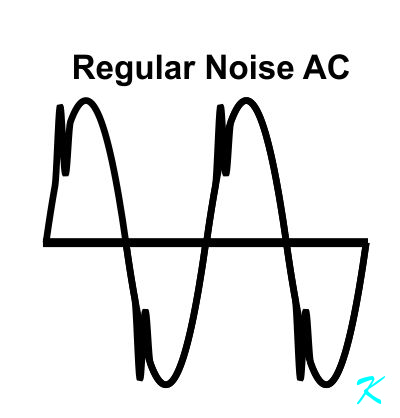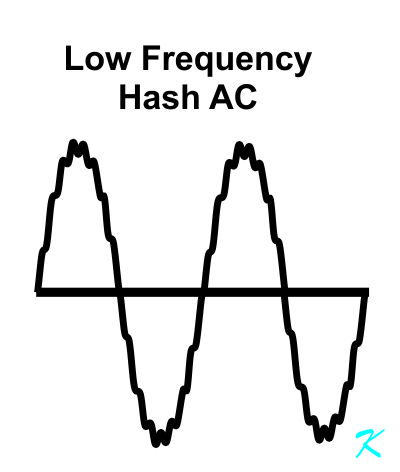"Dirty Power" is a generic description covering many possible problems. I don't know if "Dirty Power" is the cause of your program corruptions, but it does bear looking into.
Clean power is what comes out of a generator; it's a perfect voltage sinewave. Dirty power is that same clean sinewave, but with unwanted voltage signals added to, or riding on, that clean sinewave.
Clean AC Power
Originally, when nothing is connected to a generator, the voltage output of an AC generator will look clean, like this. It is a smooth sinewave that alternates its polarity, so it is half the time, the voltage is positive and half the time the voltage is negative.
There is only one AC signal (AC voltage) is on the wires, so if any other signals are added, they distort the AC Voltage of the originally smooth sinewave.
Induced Intermittent Signals
Added transient voltage signals don't continuously happen. Lightning is one type of transient voltage signal; it produces a very short duration voltage transient. Lightning is a source of transient voltage, but lightning is only one of many sources of transient voltages (Dirty Power).
Other sources are:
- Motors, like air handlers or air conditioning compressors, being turned off are a source of transient voltage spikes. This is especially the case if the motors don't have transient voltage suppressors (technically called snubbers)
- Switchgear (large circuit breakers) that turn off are a source. This is especially a problem if there are a lot of motors downstream of the switch
- Automatic power changeover switches for the backup generators can be the cause of the transient voltages
- Outside the building electrical service work is switching on and off the equipment inside the building. This is especially a problem when the service is performed between the outside transformer and the building
Usually, the power supply in the fire alarm system will filter out the transient voltage spikes. However, if the spike is large enough, there is a possibility that the spike can sneak through to the electronics inside the control panel.
The building's transient voltage suppressors greatly reduce the voltage spikes, unless the suppressor is worn out from being used.
Induced Electronic Buzz
One source of "Buzz" is electronic dimmers. They usually don't add voltages that are very high, but the buzz from older dimmers could be heard on close-by AM radio receivers.
Most of the time, the power supply in the control panel will filter out the buzz.
The buzz is a type of dirty power.
Hash, or Constant Low-Level Noise
Hash, or constant low level noise, for the most part is removed by the power supplies in electronic equipment. The frequency for the hash signals can be very low, say 20 Hertz, or very high, say several Megahertz. Hash can actually be a specific frequency, or it can be a broad range of random, low-level noise.
Interference Coming into the Panel on the Panel's Outputs
I have seen interfering signals coming into the panel on an output or even on the SLC. Remember, whether the signals are wanted or not wanted, signals are able to go either direction on any circuit. Even when a circuit is labeled as an output, unwanted signals are perfectly able to use the output from the panel as an input to the panel. I have seen that several times.
When a signal comes in on an output, no one knows what it is going to do.
For radio and television transmitters, they have a name for this kind of thing - Third Order Interharmonic Interference. For this kind of interference, the transmitting antenna receives another station while transmitting. The signal from the unwanted station travels into the transmitter on what should be the output of the transmitter.
With this kind of interference, the high-powered transmitter will mix the unwanted signal with its own signal and then transmit four different signals, on four different frequencies. You should see the filtering equipment that's used to prevent that from happening.
It doesn't happen very often with fire alarm equipment, but I've seen where a 60 Hz signal, riding into the control panel on the SLC produces an intermittent ground fault. Then again, I've seen a very low level 1 MHz signal coming in on a NAC output circuit producing an intermittent trouble. I've even seen a 25 Hz audio signal for supervision of overhead paging speakers corrupt the SLC for about 3 seconds every two minutes.
All of these could be considered "Dirty" signals.
When troubleshooting to find an unknown problem, all possibilities need to be on the table, until proven otherwise.
Troubleshooting
Troubleshooting is a low-hanging fruit proposition. Do the easy stuff or inexpensive stuff first, then do the harder and expensive stuff.
Have the voltage suppressors on the buildings' power checked out or replaced.
Another idea is to talk to your electrician to see what's available to locally (by the panel itself) clean up the power for the panels. To clean up the power at the fire alarm control panels' location, one possibility would be the installation of small one-to-one transformers. Your electrician might have other ideas, also.
If that doesn't work, get someone in there with a good oscilloscope to determine exactly what is causing the problems. That might take some time.
Douglas Krantz





